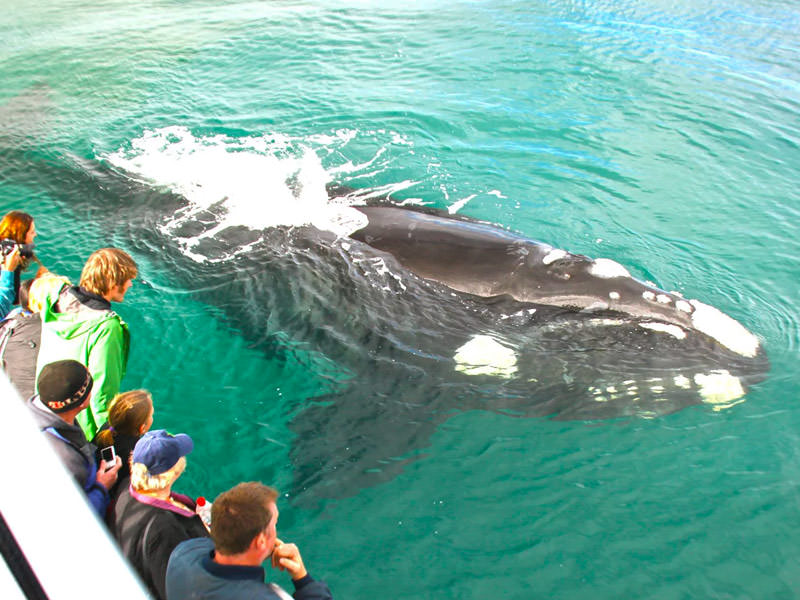Whale watching in Chile

Huge and yet delicate, whales are the most majestic animals in the world. But the only way to understand that is by being there, when the heart stops to listen to the breath of a giant that, despite being one of the friendliest mammals in the animal kingdom, could turn your barge around if it wanted to.
Every year, between November and April, whales leave the warm waters of Central America to head to Antarctica in search of food. That’s why Chile represents one of the largest whale watching locations in the entire southern hemisphere. Here we tell you where and when to see them.
Arica
With its perfect beaches, Arica is the first Chilean point on the migratory route of the whales. The way to get into its waters to look for them is simple. Just approach the fishing pier opposite the Morro and ask about the boats that offer tours to see them, as well as dolphins and sea lions. The best time of the year to see them in this area is between December and February.
Chañaral de Aceituno
This is the point in northern Chile that has been most exploited for whale watching. In February 2017, 5,000 tourists arrived for this purpose. It is located 120 kilometers to the North of La Serena and, due to the abundance of food in the area, it represents a stopping point in the migratory route of the whales.
The most frequently seen species is the fin whale, 27 meters long, but humpback, minke and blue whales can also be seen. It is also common to encounter the friendly bottlenose dolphin. To go whale-watching, simply talk to the fishermen in the cove, who charge approximately $70,000 for a boat for up to 10 people.
Punta de Choros
Already inserted in the Coquimbo region, in Punta de Choros it is also possible to find boats that go out to look for sea otters, penguins, dolphins, and when you are lucky, whales. In this sector, and specifically in the Humboldt Penguin National Reserve, humpback and blue whales have been sighted during the summer months, but mainly between January and February. In Denomades we have a tour of this national reserve.
Chiloé
The northwest of Chiloé Island and the Corcovado Gulf are internationally recognized by the scientific community as the area with the highest rate of blue whale sightings in the entire southern hemisphere. Whale watching occurs most frequently between December and April, but even sightings have been reported in June.
In the northern part of the island, you must approach Caleta Puñihuil, 25 km from Ancud, where there are boats suitable for sailing the stormy seas in search of cetaceans. The second option, which is on the southern side of Chiloé, is from Tantauco Park, where there are boats and even kayak trips to the Zorra Cove sector.
Melinka
Already in the Aysén Region, in the Guaitecas archipelago, the small island of Melinka has become a new starting point in the search for whales. During the same dates of whale watching in Chiloé, here you must hire barges suitable enough to go out to sea, since the trip can take more than 3 hours over rough seas. When entering its waters it is possible to meet families of humpback, blue and even killer whales.

Francisco Coloane Park (Punta Arenas)
About seven hours sailing from Punta Arenas, Francisco Coloane Marine Park is perhaps the best place for whale watching in all of Chile. Firstly because it has an abundant population of humpback whales and other cetaceans that find their first source of food there.
At the same time, the Park is surrounded by beautiful native forests, glaciers and imposing mountains. Apart from the humpbacks, the Sei, Minke and Orcas whales also pass through this sector. Between December and April, in Denomades we have a whale watching tour that goes through the Strait of Magellan, passing by the Francisco Coloane Park and the imposing glacier of Santa Inés Island.
Antarctica
The end point of the whales’ journey, in the Antarctic the largest number of species of this mammal converge: minke, blue, blue pygmy, fin, sei, humpback and southern right whale. From the Chilean Air Base Frei, expeditions in zodiacs are frequently carried out to meet the huge cetaceans face to face.
Sightings occur mainly between January and May, when the whales, already with their stomachs full, prepare to travel north to breed. To reach the base it is necessary to take a flight from Punta Arenas. The Chilean company Antarctica XXI combines plane and boat to explore the continent.
